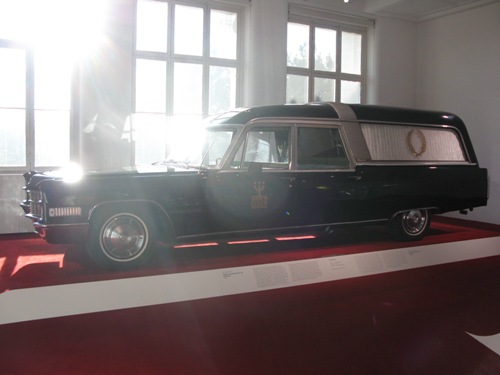
Ferrari 250 GT Berlinetta Lusso
1962
Enzo Ferrari and Herbert von Karajan were two personalities with a great deal common. Both were successful at leading: while the former took his company to the very pinnacle of the automobile world, the latter conducted the world’s best orchestras and the greatest works of music ever written. Both made music: Ferrari, with the twelve cylinders of his sports-car and racing-car engines; Karajan, with the twelve tones of the classical tonal register. And both love fast luxury cars. For a time, they were even unanimous about the make. Karajan, who initially had studied mechanical engineering in Vienna for a semester alongside music subjects, was once asked by journalists which symphony he felt was the most beautiful, to which he replied: "That of a Ferrari V12." Karajan himself admitted that no conductor could ever reproduce the harmonies of La canzone dei dodici, the song of the twelve-cylinder; it was something he could only replicate at the wheel of his 250 GT Berlinetta Lusso.
The body designed by Pininfarina and manufactured at Carrozzeria Scaglietti was used on only 350 models. The company was committed not just to producing an exceptional design and top quality, but also to exclusivity for its prominent customers, who also included Steve McQueen. And yet with time, Karajan’s passion for the car began to wane. After his second Ferrari, a blue 275 GTB, the Maestro gave preference to the 6/4 stroke from Porsche, the other great make of sports car with a rampant horse as part of its emblem.

Jaguar Type E 3.8 Litre Serie 1 Coupé
1963
The E-type was, if anything, ahead of its time in looks, performance, and trend. Its British image and distinctive design at an affordable price were other key ingredients of its market success. From now on, Jerry Cotton would be at the wheel of an E-type whenever he hunted down gangsters. The E-type was actually designed with the US market in mind, but demand rose among the target group of young sports car enthusiasts on this side of the Atlantic, too.
This E-type Jaguar was also driven by Jochen Rindt, a status symbol of stylish racing. Austrian motorsport journalist Helmut Zwickl once paraphrased the first lines of Goethe’s poem Der Erlkoenig ("Who rides here so late through night and wind – why, it's the Jaguar of Jochen Rindt") in reference to the competitive races Rindt and his friends used to undertake. The exacting demands of the 1970 Formula One Worlds Drivers' Champion (awarded posthumously) brought to light the car’s technical idiosyncrasies: the powerful engine had performance aplenty. However, the car had not been designed as a racing car, and its engine performance was often challenged, With Rindt at the wheel, the brake pads lasted an average of one week. Rindt prosaically alluded to the Jaguar’s weak points by praising his friend and mechanic Josef Borka: "If it wasn’t for Joschi, I’d have to travel by tram."

Cadillac Fleetwood Series 75
Commerce
1965
While we must all go the way of all flesh, some of us have the opportunity of doing so by car. In the Berlin of the 1960s and 1970s, the reputable firm of undertakers Julius Grieneisen offered the possibility of making that final journey in a Cadillac Fleetwood 75, complete with eight cylinders and a 7-litre engine. Over a period of 37 years, the 6.45 m hearse with its chrome and black paint was commissioned for around 100 funerals. A family may have wanted a somewhat extravagant form of transport for their deceased relative; or the event itself may have dictated the use of this US automobile with its removable rear top, converted by the coachbuilders Conrad Pollmann of Bremen. Indeed, the former president of Germany’s Reichstag, Paul Loebe, and the student Benno Ohnesorg, who was killed at a demonstrationon 2 June 1967, were each borne of the grave by this vehicle. On 16 May 1992, three flags – a US flag, a French flag, and a Berlin flag – adorned the coffin conveyed by the hearse. It was an honor awarded to Hollywood star Marlene Dietrich, who was born in Berlin-Schönefeld in 1901 and died in Paris on 6 may 1992. In 2002, the black Cadillac was again used for the funeral of the actress, singer and writer Hildegard Knef; one year later, for the actor Horst Buchholz and Guenter Pfitzmann. The hearse made its own final journey on 18 July 2003 to carry the urn of German philosopher Herbert Marcuse, who died in 1979, from Berlin Tegel to a commemorative grave at the Dorotheenstädtischer Friedhof.
